



The National Blockchain Framework (NBF), an initiative by MeitY, provides secure Blockchain-as-a-Service, powered by the Vishvasya Blockchain Stack. This indigenous technology aims to foster an Aatmanirbhar Digital India through decentralized, trusted, and accountable governance. Its applications, including Certificate Chain, Property Chain, and Judiciary Chain, are designed to enhance transparency and combat fraud.
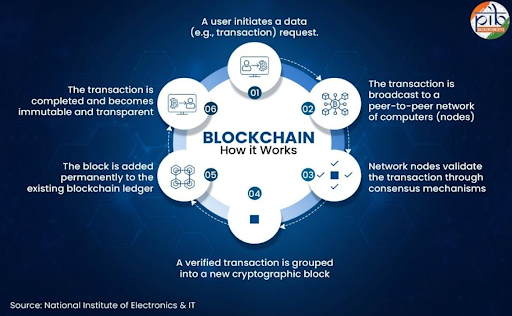
Copyright infringement not intended
Picture Courtesy: PIB
Blockchain can secure centralized governance records with a distributed, tamper-resistant ledger, offering verifiable trust without intermediaries.
The Ministry of Electronics and Information Technology (MeitY) launched the National Blockchain Framework (NBF) in 2024, with a Rs 64.76 crore budget, to establish a unified, secure, and transparent digital governance ecosystem.
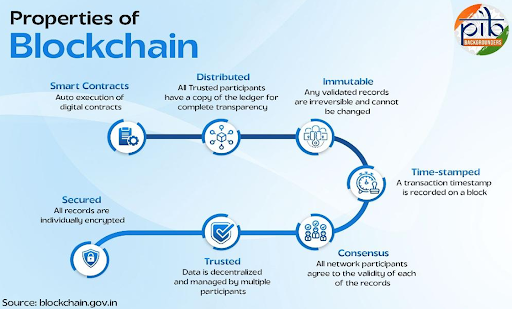
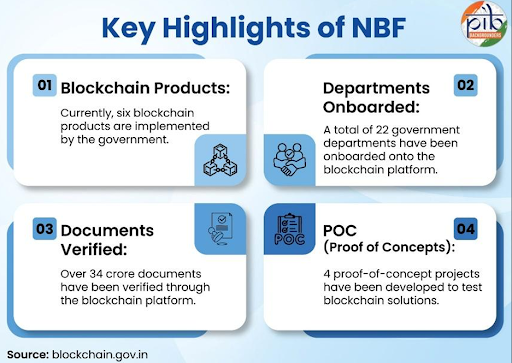
This is the indigenous and modular technology platform at the core of NBF.
It operates as a "Blockchain-as-a-Service (BaaS)," offering distributed infrastructure across National Informatics Centre (NIC) data centers in Bhubaneswar, Pune, and Hyderabad.
It provides the technical foundation for building and deploying permissioned blockchain applications, ensuring high resilience and distributed infrastructure.
NBFLite
NBFLite is a startup sandbox that provides a controlled environment for startups, research institutions, and academia to prototype and test blockchain-based applications.
It offers smart contract templates for areas like supply chain management and digital certificates, thereby lowering the barrier to entry for emerging tech firms.
Praamaanik
This blockchain solution protects users from malicious apps and fraudulent customer support by recording each app's unique details on a blockchain ledger to verify its origin.
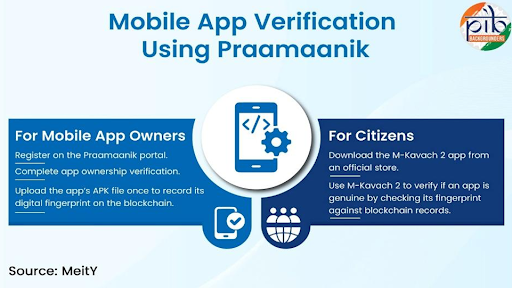
National Blockchain Portal
This online platform outlines India's strategic approach to blockchain adoption across governance and industry.
It supports innovation, standardization, and cross-sector integration of blockchain applications, promoting trust and enhancing India's leadership in emerging technologies.
Enhancing Trust and Transparency
Blockchain's immutable, distributed ledger improves data integrity, accountability, and public trust by preventing errors, fraud, and unauthorized changes.
Boosting Efficiency and Reducing Costs
Blockchain can boost government service efficiency and cut transaction costs by removing intermediaries and streamlining verification.
Combating Fraud and Corruption
Blockchain's secure, tamper-proof system is vital for protecting sensitive citizen data like land records, academic certificates, and supply chain logistics from fraud, thus directly combating corruption.
Enabling "Ease of Doing Business, Ease of Living, and Ease of Governance"
NITI Aayog's "Blockchain: The India Strategy" (2020) highlighted blockchain's potential to revolutionize interactions by allowing self-regulation through a trusted medium, reducing regulatory oversight, and empowering citizens with transparent and accountable systems.
Strengthening Digital India Initiative
The NBF aligns with the broader 'Digital India' vision by providing a robust, secure, and interoperable digital infrastructure for next-generation e-governance services.
Public Service Delivery
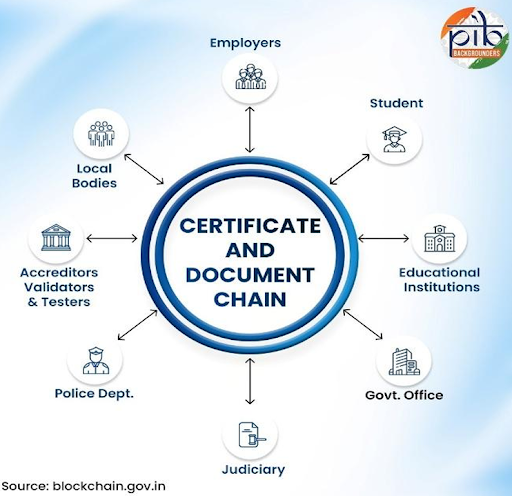
Supply Chain and Logistics
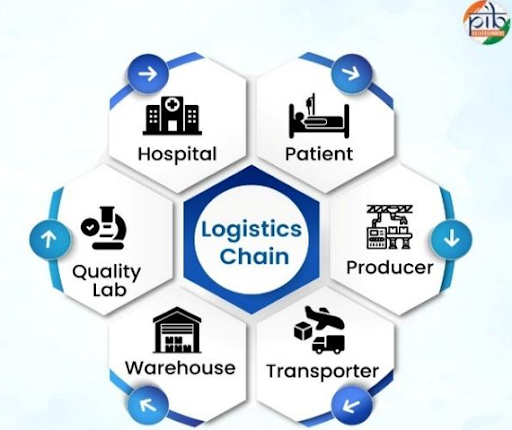
Financial Sector
Judicial System
The Judiciary Chain and Inter-Operable Criminal Justice System (ICJS) use blockchain to improve efficiency and trust by ensuring secure, time-stamped records for all judicial data.
Telecom Sector
The Telecom Regulatory Authority of India (TRAI) integrates blockchain-based Distributed Ledger Technology to improve consumer protection and compliance.
High Implementation Cost
High initial blockchain infrastructure costs impede widespread public sector adoption.
Scalability and Performance
Even permissioned blockchains struggle with the technical challenge of scaling to handle a high volume of transactions and users required for a national framework.
Interoperability Issues
Ensuring seamless communication and data exchange between different blockchain platforms and existing legacy systems remains a complex task.
Regulatory Clarity (especially concerning cryptocurrencies)
Regulatory uncertainty, despite the Supreme Court lifting the RBI's crypto ban, harms Blockchain's reputation, due to the lack of comprehensive crypto legislation.
Skill Gap and Awareness
Blockchain technology's widespread adoption is hindered by a shortage of skilled developers and a general lack of understanding among stakeholders about its benefits.
Data Privacy Concerns
NBF's permissioned blockchains provide private data on transparent, immutable ledgers, but sensitive citizen data demands careful design and robust legal frameworks.
Strengthen Capacity Building
MeitY's initiatives like FutureSkills PRIME, Post Graduate Diploma in FinTech & Blockchain Development (PG-DFBD), and training programs for government officials must expand to create a robust talent pool.
Foster Interoperability and Standardization
Developing clear, open standards for blockchain solutions will ensure seamless integration between different government departments and across various sectors, preventing data silos.
Encourage Public-Private-Academic Partnerships
Collaborative efforts between government, industry, startups, and academia are crucial for promoting blockchain innovation tailored to needs. The NBFLite sandbox is a positive step in this direction.
Develop a Progressive Regulatory Framework
India needs clear, predictable blockchain regulations that differentiate governance applications from speculative assets like cryptocurrencies to promote innovation and manage risks.
Pilot More Use Cases
Pilot blockchain applications in municipal services, healthcare, and tax systems, focusing on benefits and evaluation.
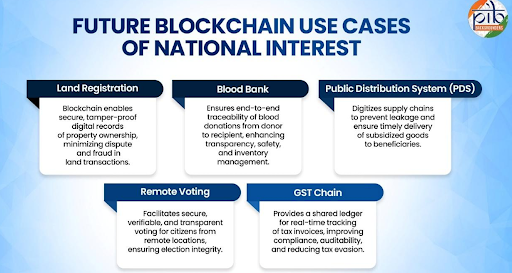
Address Ethical and Security Considerations
Maintain public trust in blockchain by implementing strong cybersecurity, regular audits, and clear ethical guidelines for data.
The National Blockchain Framework, leveraging its digital infrastructure, can implement a "Trust as a Service" model to improve governance and citizen services.
Source: PIB
|
PRACTICE QUESTION Q. What is the National Blockchain Framework (NBF)? Discuss how it enhances public service delivery. 150 words |
Blockchain is a distributed, immutable, digital ledger that securely records data across a network of computers. It is transparent, tamper-resistant, and can be used for tracking transactions and assets within a network.
Blockchain technology provides enhanced security through cryptography and increased transparency via its distributed ledger. It improves efficiency by eliminating intermediaries, offers superior asset traceability, and reduces fraud due to immutable transaction records.
Blockchain is the underlying technology, a distributed digital ledger, while cryptocurrency is a digital asset that uses blockchain for its secure transactions. While cryptocurrency is the most famous use case, blockchain has applications far beyond just digital money.

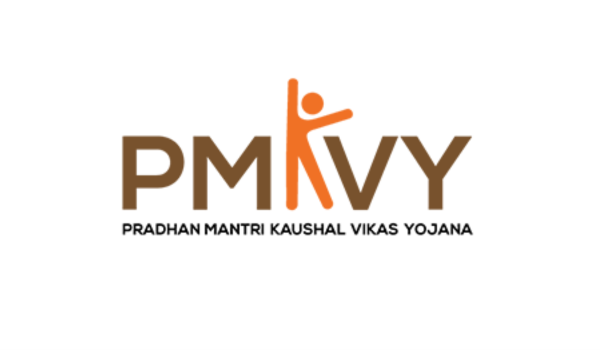




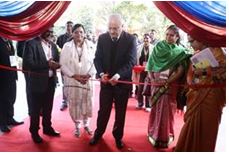

© 2025 iasgyan. All right reserved